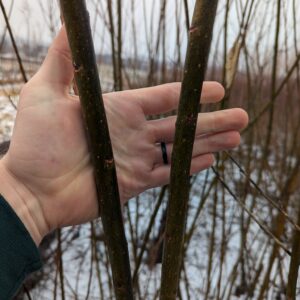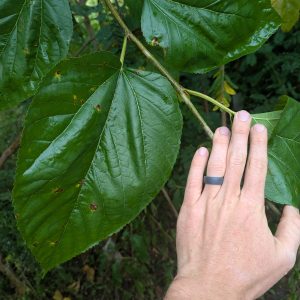Scientific Name: Robinia pseudoacacia
Family: Fabaceae (the legume, pea, or bean family)
USDA Hardiness Zone: Zone 3-9
Size: 50-80 feet tall and 35-50 feet wide with trunk diameter of 30 inches.
Roots: Fibrous with suckers (sends up new plants from underground runners)
Growth Rate: Fast Light: Prefers full sun
Moisture: Grows well in dry to moderate moisture soils. Does not like wet feet at all.
pH: 5.1-8.5 (tolerates a wide range of soil conditions)
Description: Black Locust is native to the southeastern United States (its range is in debate and should be considered adaptable with climate change), and is a great overstory tree as it allows a lot of light through to the understory. Black Locust provides valuable, highly durable and rot resistant wood as a timber tree, makes excellent firewood, and is a honey plant (bees love them!). It is also well-known for fixing nitrogen into the soil. Black Locust leaves provide a high protein fodder for livestock.
Main Silvopasture Uses:
- Shade. Fast growing, high canopy with dappled shade. In well-drained sites, it’s our most recommended species for fast shade. It also can last longer than willows and poplars, our other fast-growing shade species.
- Nitrogen fixer. Known to be one of the most prolific plants to fix atmospheric nitrogen into the soil.
Other Uses:
- Wood. Even though it grows fast, the very rot resistant wood is a great option for poles and posts. Burns really well and long, but also sparks, so watch where you burn it. Often doesn’t get to the size needed for a real timber tree, given attacks by locust borers. Coppices and pollards well, but is more likely to sucker then.
- Fodder/Forage Plant. Leaves contain an average of 20% crude protein and are comparable to alfalfa. Used around the world as a browse forage in silvopastures. However, it is considered toxic to horses by contemporary vet medicine. We typically don’t consider it to be a main species to plant for fodder use. The fact that you’ll get a lot of thorns on the ground, and thorns to handle when pollarding, makes it less attractive than poplars or willows, or even species like mulberry and basswood that are primarily used for fodder. Nonetheless, black locust has high quality leaf fodder, and should be considered a solid option, in moderation, in the right context.
- General insect (especially bees) nectar plant. Tree is well-loved by beekeepers.
Special Considerations:
- The Locust Borer (Megacyllene robiniae) is a beetle which is native to the southeastern U.S. where the Black Locust originates. The larvae riddle the trunk and branches with tunnels making the wood unfit for timber. This pest was responsible for reducing the Black Locust’s significance as a commercial timber tree in the United States. Black Locust will grow well for many years, but rarely get large enough for timber due to this pest’s activity in certain areas and climate. Maintaining healthy, vigorous trees and promoting Locust Borer predators seem to significantly minimize borer damage. Some clonal selections have been made that are more resistant to borer damage, which TFG is exploring.
- Expansive. Black Locust can form a thicket from shoots arising from roots. Will need to manage suckers, especially if the Black Locust is being coppiced. Suckers do give the opportunity for ‘free trees’ that can be managed for timber, especially in a context where trees are randomly spaced (as opposed to rows you need to maintain) like in a woodland. Brett Chedzoy, a NY forester and grazier, has had good success spreading his black locust across his farm through simply managing sprouts that come up naturally.
- Considered an “invasive species” in some states. Check with your state to see if black locusts are allowed in plantings, and plan accordingly.
- Thorny. Not as thorny as the Honey Locust (a distant relative). Thorns are on young branches only. Once the branches or trunk get a few inches thick, the thorns disappear
- Branches can be brittle and easily broken in strong winds. Even though the wood is famously strong and durable, the living tree is not particularly durable.
- Toxicity. Black Locust is also known to be poisonous to horses by contemporary veterinary medicine, although it is considered an excellent pasture livestock feed globally, and valuable for many livestock when used in moderation. Care should be taken by the planner and land steward to avoid scenarios where livestock might overfeed, such as if they don’t have access to other quality feed and all of a sudden get access to a lot of black locust.



